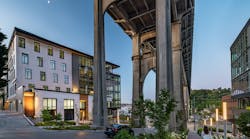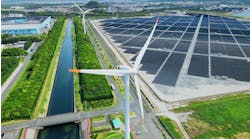Known for its quirky shops and lively restaurant and arts scene, Seattle’s Fremont neighborhood is a natural fit for the Watershed building. Sleek as it is intelligent, the seven-story, mixed-use building with a glass curtain wall and planted terraces goes beyond being one of the area’s most healthy and high-performing buildings: It extends a hand to its neighbor, the state-owned George Washington Memorial Bridge, also known as Aurora Bridge.
Why not improve the entire ecosystem?
Constructed between 2018 and 2020, Watershed consists of approximately 72,000 square feet of street-level retail space and Class A+ office space. Its commercial office tenants include its own designer, Weber Thompson, a full-service architecture, landscape architecture, and interiors firm.
Watershed is one of a handful of projects enrolled in Seattle’s Living Building Pilot Program. In exchange for meeting the requirements for Petal certification from the International Living Future Institute’s Living Building Challenge (LBC), the pilot projects are eligible for several construction benefits, including up to 25% more floor area, 15 feet of additional height, and departure from other Seattle Municipal Code requirements, such as size of use, parking access, open space, and structural building overheads.
Watershed is pursuing LBC’s Materials Petal, which requires projects to use only responsible, nontoxic, transparent, and socially-equitable building materials that do not appear on LBC’s Red List. Watershed’s other design and performance accolades include a three-star Fitwel certification—the highest level—for occupant health; and Salmon-Safe certification for meeting land and water management practices that protect Pacific salmon.
Weber Thompson principal and sustainability director Myer Harrell says LBC’s Materials Petal and Fitwel certifications helped set the framework for a healthy building and provided value from a leasing point of view. But achieving them wasn’t easy. The Materials Petal requires architects to ensure each building product offers transparency “through material disclosure and environmental and health product declarations,” Harrell says. “It gets rather complicated when you need every supplier and their suppliers to disclose material percentages for every product. And each tenant has to meet the requirements. We help by providing them with lists of compliant elements that they can leverage for everything from carpets to workstations.”
Watershed’s environmental stewardship extends beyond its walls. With its cantilevered roof and sculptural gutter system, the building captures and carries rainwater to a 20,000-gallon cistern for reuse. Even more notable, its 12,811-square-foot site incorporates a series of bioretention planters and steel weirs that filters and treats up to 400,000 gallons of toxic runoff from the Aurora Bridge annually—runoff that has been a longtime source of pollution in Lake Union, which connects to the Puget Sound.
That runoff now flows into bridge downspouts that terminate just above the street from where the steep grade of its underlying road allows swales to step and overflow through Watershed’s natural filtration system. The runoff treatment factors into Watershed’s Salmon Safe certification, but represents a voluntary effort separate from the Living Building Pilot—one that required additional approvals from city and state departments of transportation.
Technology to help ensure performance
Smart building technology ensures that Watershed continues to meet its energy and water goals post-occupancy. “Floors three through six feature self-tinting electrochromic glass that uses connected sensors and solar clocks to automatically adjust and decrease heat and glare for energy efficiency, as well as occupant comfort,” Harrell says. A dashboard publicly displays the building’s real-time energy and water usage. Behind the scenes, he adds, Weber Thompson is “collecting even more granular data from system meters and submeters to determine usage by system and square footage.”
Other deployed technologies include LED lighting systems, occupancy sensing, master switching to control all lights, workstation outlet control, wayfinding, and digital and educational signage throughout the building.Designing the infrastructure and metering to ensure a more centralized approach for data collection and building systems integration took some work, Harrell says. Overseen by general contractor Turner Construction, the infrastructure was designed by global engineering firm WSP and the metering systems were custom engineered by ATS Automation. Building data uploaded to the cloud for analysis and reporting helps ensure that Watershed continues to meet the water and energy metrics required by the Seattle Living Building Pilot Program, as well as those by the Washington state stormwater code. The latter requirements include the reuse of at least 50% of stormwater and cutting potable water use to 75% below Seattle’s baseline target.
“Every tenant has a budget on energy and water usage, and property management uses the data to ensure they stay within their assigned budget,” Harrell says. “The data can also identify patterns for making adjustments to systems and occupant behavior as needed.” Weber Thompson plans to leverage the information, including the more granular data, to further educate its own architects on high-performance building design.
With Watershed now open and its office spaces fully occupied, the next step is to bring in retail tenants to enliven both its ground-level and the surrounding Fremont neighborhood. Public tours of Watershed will also begin in May.
PROJECT CREDITS
Owner/Developer: Fremont Watershed Realty, a partnership of Spear Street Capital, Stephen C. Grey & Associates, and Hess Callahan Grey Group
Architect: Weber Thompson—Kristen Scott (principal in charge), Cody Lodi (lead designer), Myer Harrell (project manager)
Interior Designer: Weber Thompson
Landscape Architect: Weber Thompson
Civil Engineer: KPFF
Structural Engineer: DCI Engineers
MEP Engineer: WSP
Geotechnical Engineer: PanGeo, Inc.
Lighting Designer: WSP
Building Envelope Consulting: Allana Buick & Bers
Transportation Engineer: Heffron Transportation, Inc.
Specifications: Applied Building Information
Construction Manager: First Western Development Advisors
General Contractor: Turner Construction Co.
Smart Building Consultant: WSP
Living Building Consultant: Skanska
System Integrator: ATS Automation
Commercial Broker: JLL
PRODUCTS
Concrete: CalPortland
Glass: Vitro (low-E glass); View (smart windows)
Gypsum: USG
HVAC: Mitsubishi
Lighting Control: Lutron
Plumbing/Water: Wahaso (water harvesting solutions)
Roofing: Carlisle SynTec Systems
Structural: Nucor-Yamato Steel
Walls: SCAFCO Steel Stud Co.
Windows/Curtainwalls/Doors: Oldcastle BuildingEnvelope



